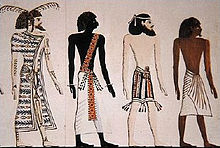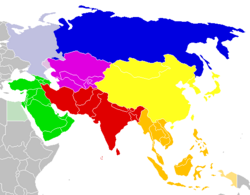亚洲人
外观
此条目内容疑欠准确,有待查证。 (2009年8月19日) |
| 亚洲人 | |
|---|---|
| 总人口 | |
| 4,533,765,005 世界总人口的59.4%[1] | |
| 分布地区 | |
| 南亚、东亚和东南亚[2] |
|
| 1,384,688,986[3] | |
| 1,296,834,042[4] | |
| 262,787,403[5] | |
| 164,098,818[6] | |
| 126,168,156[7] | |
| 100,006,900[8] | |
| 97,040,334[9] | |
| 68,615,858[10] | |
| 51,418,097[11] | |
| 34,219,975[12] | |
| 23,545,963[13] | |
| 15,288,489[14] | |
| 7,213,338[15] | |
| 5,996,000[16] | |
| 西亚和中亚 |
|
| 81,257,239[17] | |
| 33,091,113[18] | |
| 19,454,263[19] | |
| 18,744,548[20] | |
| 10,458,413[21] | |
| 9,701,315[22] | |
| 8,424,904[23] | |
| 5,469,612[24] | |
| 4,683,000[25] | |
| 语言 | |
| 亚洲的语言 (汉语、印地语、阿拉伯语、孟加拉语、日语、泰米尔语、菲律宾语、印尼语、朝鲜语、泰语和越南语等) | |
| 宗教信仰 | |
| 佛教、印度教、儒教、道教、基督教[26]、伊斯兰教和神道教等 | |

亚洲人指的是生活在亚洲大陆的族群。
语境
[编辑]
亚洲人的定义在不同的时空背景下各有不同:例如在古埃及的文献中,“亚洲人”指的是埃及国境以外、非洲大陆以东的人们,指的是今日的中东人。
在美国、加拿大及澳大利亚,亚洲人一词通常指东亚和东南亚人;而在英国及英语系非洲国家,亚洲人通常指南亚人。[27][28]。
| 联合国区域分类方法[29] |
|---|
其他
[编辑]另外,在世界各地,也指出生于某个亚洲国家、或某个亚洲以外国家的,父母中至少有一人含有亚洲血统的人,对此类群体中文里更准确的名词是“亚裔”。
参考
[编辑]- ^ [1] 互联网档案馆的存档,存档日期July 21, 2019,. Worldometers.info
- ^ Land Use - Ecosystem - Climate Interactions in Monsoon Asia. lcluc.umd.edu. NASA. [February 15, 2020]. (原始内容存档于January 10, 2021).
- ^ The World Factbook. Cia.gov. Central Intelligence Agency. [May 27, 2019]. (原始内容存档于2021-02-13).
- ^ The World Factbook. Cia.gov. Central Intelligence Agency. [May 27, 2019]. (原始内容存档于2021-03-18).
- ^ The World Factbook. Cia.gov. Central Intelligence Agency. [May 27, 2019]. (原始内容存档于2021-04-13).
- ^ The World Factbook. Cia.gov. Central Intelligence Agency. [May 27, 2019]. (原始内容存档于2021-07-30).
- ^ The World Factbook. Cia.gov. Central Intelligence Agency. [May 27, 2019]. (原始内容存档于2021-01-05).
- ^ The World Factbook. Cia.gov. Central Intelligence Agency. [May 27, 2019]. (原始内容存档于2021-06-10).
- ^ The World Factbook. Cia.gov. Central Intelligence Agency. [May 27, 2019]. (原始内容存档于2021-06-10).
- ^ The World Factbook. Cia.gov. Central Intelligence Agency. [May 27, 2019]. (原始内容存档于2021-06-10).
- ^ The World Factbook. Cia.gov. Central Intelligence Agency. [May 27, 2019]. (原始内容存档于2021-01-29).
- ^ The World Factbook. Cia.gov. Central Intelligence Agency. [May 27, 2019]. (原始内容存档于2021-03-12).
- ^ The World Factbook. Cia.gov. Central Intelligence Agency. [May 27, 2019]. (原始内容存档于2021-01-09).
- ^ The World Factbook. Cia.gov. Central Intelligence Agency. [February 15, 2020]. (原始内容存档于2021-06-10).
- ^ The World Factbook. Cia.gov. Central Intelligence Agency. [May 27, 2019]. (原始内容存档于2021-06-10).
- ^ The World Factbook. Cia.gov. Central Intelligence Agency. [May 27, 2019]. (原始内容存档于2021-03-20).
- ^ The World Factbook. Cia.gov. Central Intelligence Agency. [Dec 31, 2019]. (原始内容存档于2021-01-10).
- ^ The World Factbook. Cia.gov. Central Intelligence Agency. [Dec 31, 2019]. (原始内容存档于2021-08-27).
- ^ The World Factbook. Cia.gov. Central Intelligence Agency. [Dec 31, 2019]. (原始内容存档于2021-01-09).
- ^ The World Factbook. Cia.gov. Central Intelligence Agency. [Dec 31, 2019]. (原始内容存档于2021-01-09).
- ^ The World Factbook. Cia.gov. Central Intelligence Agency. [Dec 31, 2019]. (原始内容存档于2021-06-03).
- ^ The World Factbook. Cia.gov. Central Intelligence Agency. [Dec 31, 2019]. (原始内容存档于2022-01-07).
- ^ The World Factbook. Cia.gov. Central Intelligence Agency. [Dec 31, 2019]. (原始内容存档于2021-09-13).
- ^ Middle East :: Lebanon — The World Factbook - Central Intelligence Agency. www.cia.gov. [19 April 2020]. (原始内容存档于2021-09-23).
- ^ Estimated Population in the Palestinian Territory Mid-Year by Governorate,1997–2016. Palestinian Central Bureau of Statistics. State of Palestine. [8 June 2014]. (原始内容存档于8 June 2014).
- ^ Analysis. Global Christianity. Pew Research Center. 19 December 2011 [17 August 2012]. (原始内容存档于2018-12-26).
- ^ Color Q World. Clarifying the Definition of Asian. 2005. October 1, 2006. [2] (页面存档备份,存于互联网档案馆)
- ^ 牛津当代大辞典. 2001. New York: Oxford University Press.
- ^ United Nations regional classification scheme. [2009-11-27]. (原始内容存档于2018-12-25).

